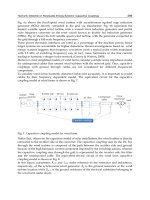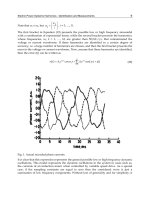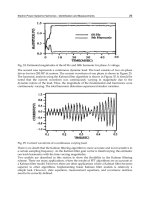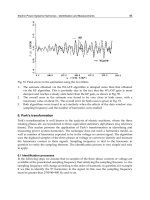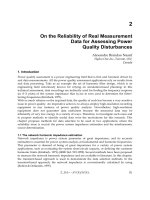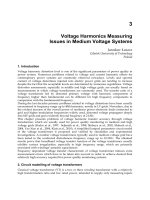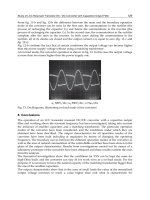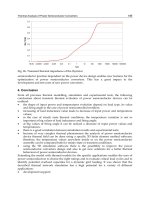Power Quality Harmonics Analysis and Real Measurements Data Part 15 doc
Bạn đang xem bản rút gọn của tài liệu. Xem và tải ngay bản đầy đủ của tài liệu tại đây (483.28 KB, 10 trang )
Harmonic Distortion in Renewable Energy Systems: Capacitive Couplings
269
Fig. 6a shows the fixed-speed wind turbine with asynchronous squirrel cage induction
generator (SCIG) directly connected to the grid via transformer. Fig. 6b represents the
limited variable speed wind turbine with a wound rotor induction generator and partial
scale frequency converter on the rotor circuit known as doubly fed induction generator
(DFIG). Fig. 6c shows the full variable speed wind turbine, with the generator connected to
the grid through a full-scale frequency converter.
These power electronic interfaces are rated as a percentage of the machine power, hence
larger systems are accountable for higher distortions. Recent investigations based on wind
energy systems suggests that frequency converters (with a typical pulse width modulated
with 2.5 kHz of switching frequency) can, in fact, cause harmonics in the line current,
leading to harmonic voltages in the network (Conroy & Watson, 2009).
Moreover, most simplified models of wind farms consider a simple series impedance model
for underground cables that connect wind turbines with the network grid. Thus, capacitive
couplings with ground through cables are not considered for different frequencies
components.
To simulate wind farms harmonic distortion behaviour accurately, it is important to model
cables by their frequency dependent model. The equivalent circuit for the capacitive
coupling model of wind farms is shown in Fig. 7.
Fig. 7. Capacitive coupling model for wind farm.
Notice that, otherwise the capacitive model of solar installations, the wind turbine is directly
connected to the rectifier side of the converter. The capacitive coupling seen by the DC bus
through the wind turbine is composed of the path between the rectifier side and ground
because of the high harmonic current component imposed by the switching actions, whereas
the capacitive coupling seen through the grid is represented by the inverter side, the filter
and the underground cable. The equivalent electric circuit of the wind farm capacitive
coupling model is shown in Fig. 8.
In this figure, parameters R
WG
and L
WG
make reference to the resistance and inductance,
respectively, of the synchronous wind generator. R
g
is the ground resistance at the wind
turbine location while R
q_es
is the ground resistance of the electrical substation belonging to
the wind farm under study.
Power Quality Harmonics Analysis and Real Measurements Data
270
C
rectifier
and C
ac_cable
are the capacitive couplings of the rectifier side and underground cable,
respectively, with ground. R
ac_cable
and L
ac_cable
make reference to the resistance and
inductance, respectively, of the synchronous wind generator. L
filter
and C
filter
are the
dimensions of the filter. L
TR
is the equivalent impedance of the power transformer and L
source
the thevenin impedance of the source. The variables v
WT
(t) and v
source
(t) are the voltages at
wind generator node and network grid source, respectively. The input voltage v
in
(t) is the
voltage injected into the grid by the inverter side.
R
g_es
R
g
R
WG
L
WG
C
rectifier
L
filter
R
ac_cable
L
ac_cable
L
source
Converter
Rectifier
circuit
Inverter
circuit
v
in
(t)
i
3
(t)
v
WG
(t)
L
TR
v
source
(t)
i
4
(t)
i
1
(t)
C
filter
i
2
(t)
C
ac_cable
C
ac_cable
v
2
(t)
v
3
(t)
Fig. 8. Equivalent electric circuit belonging to the wind farm capacitive coupling.
The state variable representing this model can be deduced in a similar way as expressed in
Section 2. Nonetheless, the effect of capacitive couplings in wind farms is more significant at
the inverter circuit through the power grid where the circuit of the filters and cables exert an
important influence over the ground currents.
The continuous time equations that describe the transfer function between the input voltage
v
in
(t) and the network grid v
source
(t) are the following
1
2
() 1
() ()
in
filter
di t
vt vt
dt L
(6)
2
13
_
() 1
() ()
filter ac cable
dv t
it it
dt
CC
(7)
3
23 _ 3
_
()
1
() () ()
ac cable
fac cable
di t
vt itR vt
dt L
(8)
334
_
() () ()
ac cable
dv t i t i t
dt C
(9)
3
4
()
()
TR source
vt
di t
dt L L
(10)
The electric parameters related to the capacitive coupling model of Fig. 8 are shown in Table 2.
In Fig. 9a, the ground voltage measurement is shown while in Fig. 9b the FFT analysis for this
waveform is shown. It is observed that the harmonics components near the switching
frequency are considerably higher than the fundamental component. Harmonics components
70 (3500 Hz) is 575% of fundament component magnitude which is 3.05 V. That means that
Harmonic Distortion in Renewable Energy Systems: Capacitive Couplings
271
harmonic 70 has a magnitude of 17.54 V, as shown in Fig. 9a. Moreover, the multiples of the
switching frequencies are also considerable respect to the fundamental component, as shown
in Fig. 9b, where the harmonic component 138 (7000 Hz) and 210 (10500 Hz) are
approximately 145% and 98%, respectively, of the fundamental component magnitude.
The ground current waveform measured at the wind farm is shown in Fig. 10a, and the FFT
analysis concerning this waveform is performed in Fig. 10b. Consistently with the voltage
waveform, the dominant harmonic component in the ground current fits the switching
frequency of the converter. That is harmonic component 68 with 503% of the fundamental
component magnitude which is 168 mA. Thus, the magnitude of harmonic 68 is 844.9 mA.
Element Parameter Value
Wind generator
Operation voltage 3.5 kV
Operation frequency 50 Hz
Nominal power 1400 kVA
Stator winding resistance 0.01196 pu
Stator leakage reactance 0.1966 pu
Full converter
Nominal power 1800 kVA
Switching frequency 3500 Hz
Topology 6 pulses
Capacitive coupling 0.8 uF
Filter
Q factor 10
Cut-off frequency 1000 Hz
Nominal power 530 kVA
Underground cable
Positive sequence impedance
0.09015+j 0.0426 /km
Zero sequence impedance
0.0914 + j 0.03446 /km
Zero sequence susceptance 0.327 mS/km
Power grid
Thevenin voltage 3.5 kV
Thevenin inductance 0. 231 mH
Table 2. Electric parameters for the wind farm capacitive grounding model.
The multiples of the switching frequencies are also significant, as shown in Fig. 10b,
however harmonic component 140 (7000 Hz) appears higher than in the ground voltage
waveform near to 200% while harmonic 210 (10500 Hz) is less dominant, 56% but still high
enough in comparison with the fundamental component.
These simulation results indicate that ground current in wind farms can be considerable
according to the values expressed in (IEEE 80-2000, 2000) for the range of frequencies
expressed at Fig. 10a. Therefore, care is then needed to ensure that ground current is within
safe limits of work.
This issue is one of the most significant advantages of considering capacitive coupling
models for wind farms, which allows implementing further corrective actions to mitigate
the adverse effect of ground current over safe conditions of work.
The capacitive coupling model detects the expected resonant frequency of the wind farm at
11.0 kHz with an impedance magnitude Z of 77.8 while simplified models does not detect
a resonant frequency for this wind farm configuration, as shown in Fig. 11.
Power Quality Harmonics Analysis and Real Measurements Data
272
2.000 2.005 2.010 2.015 2.020
-0.050
-0.025
0.000
0.025
0.050
Voltage (kV)
Time (s)
(a)
Magnitude (% of fundamental component)
Frequency (Hz)
0 4000 8000 12000
600
450
300
150
0
(b)
Fig. 9. Simulation result of the capacitive coupling model: (a) voltage waveform between
wind farm electric circuit and grounding system and (b) FFT analysis of the voltage
waveform obtained.
Harmonic Distortion in Renewable Energy Systems: Capacitive Couplings
273
3.000 3.005 3.010 3.015 3.020
-0.0010
-0.0005
0.0000
0.0005
0.0010
Ground current (kA)
Time (s)
(a)
Magnitude (% of fundamental component)
Frequency (Hz)
0 4000 8000 12000
600
450
300
150
0
(b)
Fig. 10. Simulation result of the capacitive coupling model: (a) waveform between wind
farm electric circuit and ground and (b) FFT analysis of the ground current obtained.
Power Quality Harmonics Analysis and Real Measurements Data
274
0
100
200
300
400
500
600
700
800
0 2000 4000 6000 8000 10000 12000 14000 16000 18000 2000
0
Capacitive cooupling model |Z|
Simplified model |Z|
Impedance |Z| ()
Frequency (Hz)
Fig. 11. Resonance frequency of the wind farm model without considering capacitive
coupling (dashed line) and with capacitive couplings (solid line).
4. Impact on distribution networks of DG ground current contribution
The distribution network considering DG, shown in Fig. 12, has been modelled to analyze the
effects of wind farms and PV solar installations ground current contribution to the network.
The DG is based on capacitive coupling models of a 1 MW PV solar installation and a 1.4 MW
wind farm with the electric parameters shown in Table 1 and Table 2, respectively.
This distribution network feeds two loads through a multi-terminal ring topology. These
loads are connected to bus 2 and 5 with a rated power of 500+ j 25 kVA each one.
In steady state conditions, the wind farm generates a total active power of 1370 kW, and the
PV solar installation delivered 940 kW to the distribution network. To analyse the capacitive
coupling effect over the ground current in DG systems, it has been noticed the voltage and
current waveforms seen at node 5 through the capacitive coupling of the line.
15 kV
50 Hz
Zth
Network
grid
5 km
3.1 km
Solar PV
1000 kW
Wind
genera tor
1400 kVA
P= 500 kW
Q= 25 kvar
P= 500 kW
Q= 25 kvar
3
2
4
5
2.5 km
10.5 km
15.1 km
1
Fig. 12. Distribution network based on capacitive coupling model of wind farms and solar
installations.
Harmonic Distortion in Renewable Energy Systems: Capacitive Couplings
275
The electric parameters of the network grid are shown in Table 3.
Element Parameter Value
Power grid
Thevenin voltage 15 kV
Thevenin inductance
17.938
Shortcircuit power 12.54 MVA
Underground cable
Positive sequence impedance
0.6969 +j 0.492 /km
Zero sequence impedance
5.945 + j 7.738 /km
Zero sequence susceptance 2.13 µS/km
Table 3. Electric parameters of the network grid.
In node 5, the phase voltage waveform meets the standard regulation of harmonic distortion
(THD=5.4%) with a fundamental component of 8.72 kV, as shown in Fig. 13.
3.80 3.81 3.82 3.83 3.84 3.85 3.86
-15.0
-10.0
-5.0
0.0
5.0
10.0
15.0
Voltage (kV)
Time
(
s
)
(a)
(b)
Fig. 13. Simulation result of the distribution network: (a) phase voltage waveform and (b)
FFT analysis of the waveform obtained, at node 5.
Power Quality Harmonics Analysis and Real Measurements Data
276
Although voltage waveform meets standard regulations, it has been observed an important
ground current contribution through the admittance of the underground cables. The ground
voltage waveform has a considerable magnitude with peaks reaching 7 V, as shown in Fig.
14. Likewise, the ground current measurement due to the capacitive coupling of these
underground cables is also significant as shown in Fig. 15.
The fundamental component of the current waveform is 313 mA, and the THD of this
waveform is 190.78%. The most predominant harmonic components are harmonic 72 with
145.22% of the fundamental component, followed by harmonic 70 and 76 with 98.29% and
58.75%, respectively, as shown in Fig. 15a.
3.80 3.81 3.82 3.83 3.84 3.85 3.86
-0.008
-0.006
-0.004
-0.002
0.000
0.002
0.004
0.006
0.008
0.010
Voltage (kV)
Time
(
s
)
Fig. 14. Simulation result of the distribution network ground voltage waveform at node 5.
These observations point to the importance of controlling the capacitive coupling in load
installations connected to networks with DG. Otherwise, end users equipments can be
exposed to malfunctioning and lifetime reduction due to the capacitive ground current.
Moreover, GPR can reach values of unsafe work conditions.
5. Conclusions
The capacitive coupling models lead to an accurate approximation to the response of
distribution network against the frequency spectrum imposed by the switching action of the
converters at DG. This approximation is not feasible using simplified models because of the
bandwidth limitation for high frequencies.
According to the distribution network under study, a high ground current contribution to
grid provided by DG has been detected. Therefore, some preventive actions can be applied
to network design stage in order to solve this problem, such as:
-
Connection of the PV array to the grounding systems by means of an inductor. The
latter element represents high impedance for harmonics current and subsequently
reduces the capacitive ground current in the installation.
-
Insertion of capacitors between the DC terminals and ground avoids the injection of
harmonic current to the PV array, as shown in Fig. 13b, and thereby the noise level and
GPR between PV modules and ground is minimized.
Harmonic Distortion in Renewable Energy Systems: Capacitive Couplings
277
3.80 3.81 3.82 3.83 3.84 3.85 3.86
-0.0015
-0.0010
-0.0005
0.00
0.0005
0.0010
0.0015
0.0020
Current (kA)
Time (s)
(a)
(b)
Fig. 15. Simulation result of the distribution network: (a) current waveform and (b) FFT
analysis of the waveform obtained, at node 5.
-
Adjustment of the firing pulses frequencies and control strategies to reduce or avoid
resonance and capacitive currents by analyzing the ground current with the proposed
model.
-
Insertion of high-pass filters on the distribution network to avoid end users equipments
to be exposed to a high amount of ground current.
6. References
Bellini A., Bifaretti S., Iacovone V. & Cornaro C. (2009). Simplified model of a photovoltaic
module, International Conference on Applied Electronics, pp. 47–51, ISBN 978-80-7043-
781-0, Pilsen, Bohemia, Czech Republic, Sept. 9-10, 2009
Chayawatto N., Kirtikara K., Monyakul V., Jivacate, C. & Chenvidhya D. (2009). DC/AC
switching converter modeling of a PV grid-connected system under islanding
phenomena, Renewable Energy, Vol. 34, No. 12, (2009), pp. 2536–44, ISSN 0960-1481
Power Quality Harmonics Analysis and Real Measurements Data
278
Chicco G., Schlabbach J. & Spertino F., (2009). Experimental assessment of the waveform
distortion in grid-connected photovoltaic installations, Solar Energy, Vol. 83, No. 1,
pp.1026–39, (2009), ISSN 0038-092X
Comech, M.P., García-Gracia, M., Borroy, S., Villén, M.T. (2010). Protection in Distributed
Generation, In: Distributed Generation, D. N. Gaonkar, pp. 289-310, In-Teh, ISBN
978-953-307-046-9, Olajnica, Vukovar, Croatia
Conroy, J. & Watson, R. (2009). Aggregate modelling of wind farms containing full-
converter wind turbine generators with permanent magnet synchronous machines:
transient stability studies, IET Renewable Power Generation, Vol. 3, No. 1, (2009), pp.
39–52, ISSN 1752-1424
Dugan, R. C., McGranaghan, M. F., Santoso, S. & Wayne Beaty, H. (2002). Electrical Power
Systems Quality, McGraw-Hill, (2
nd
Ed.), ISBN 0-07-138622-X, New York, USA
García-Gracia, M., El Halabi, N., Khodr, H.M. & Sanz, J. F. (2010). Improvement of large
scale solar installation model for ground current analysis, Applied Energy, Vol. 87,
No. 11, (2010), pp. 3467-3474, ISSN 0306-2619
IEC 60479-2 (1987). Effect of current passing through human body. Part II: special aspects.
The International Electrotechnical Commission, 1987.
IEC Std. 61000-4-7 (2002). Electromagnetic compatibility (EMC). Part 4-7: Testing and
measurement techniques. General guide on harmonics and interharmonics
measurements and instrumentation for power supply and equipment connected
thereto, International Electrotechnical Commission, (2002)
IEC Std. 61400-21 (2008), Wind turbines. Part 21: Measurement and assessment of power
quality characteristics of grid connected wind turbine, International Electrotechnical
Commission, (2008).
IEEE Std 519-1992 (1992). (1992). IEEE recommended practices and requirements for harmonic
control in electrical power systems, Power Engineering Society, 1992
IEEE Std. 80-2000 (2000). IEEE guide for safety in AC substation grounding, IEEE Power
Engineering Society, 2000
Iliceto A. & Vigotti R. (1998). The largest PV installation in Europe: perspectives of
multimegawatt PV, Renewable Energy, Vol. 15, No. 1-4, (1998), pp. 48–53, ISSN 0960-
1481
Kim S-K., Jeon J-H., Cho C-H., Kim E-S., Ahn J-B. (2009). Modelling and simulation of a
grid-connected PV generation system for electromagnetic transient analysis, Solar
Energy, Vol. 83, No. 5, (2009), pp. 664–78, ISSN 0038-092X
Luna, A., De Araujo, F., Santos, D., Rodriguez, P., Watanabe, E. & Arnaltes, S. (2011).
Simplified Modeling of a DFIG for Transient Studies in Wind Power Applications,
IEEE Transactions on Industrial Electronics, Vol. 58, No. 1, (2011), pp. 9–20, ISSN
0278-0046
Sukamongkol SCY & Ongsakul W. (2002), A simulation model for predicting the
performance of a solar photovoltaic system with alternating current loads,
Renewable Energy, Vol. 27, No. 2, pp. 237–58, (2002), ISSN 0960-1481
Villalva M., Gazoli J, Filho E. (2009), Comprehensive approach to modeling and simulation
of photovoltaic arrays, IEEE Transactions Power Electronics, Vol. 24, No. 5, pp. 1198–
208, (2009), ISSN 0885-8993
Zhou, W., Lou, C., Li, Z., Lu, L., & Yang, H. (2010). Current status of research on optimum
sizing of stand-alone hybrid solar-wind power generation systems, Applied Energy,
Vol. 87, No. 2, pp. 380–389, ISSN 0306-2619
